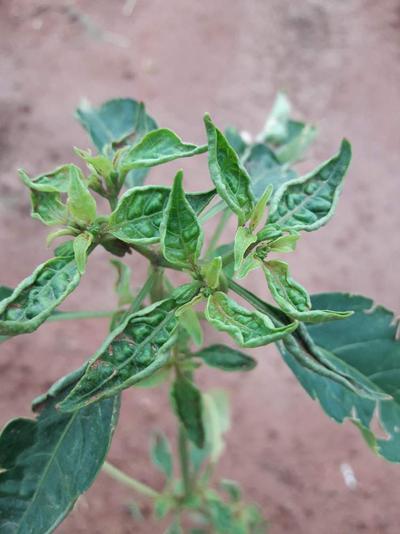Chilli Thrips
Scirtothrips dorsalis
Insect
In a Nutshell
- Leaves curl upwards.
- Early defoliation of plant.
- Flowers and fruits also affected.
- Small and slender insects with blackish brown body and yellowish wings.
Can also be found in
Symptoms
Both nymphs and adults feed on the underside of young leaves. They rasp and pierce the tissues and suck the oozing liquids. The infested leaves develop light brown to silvery spots and may show signs of deformation (curling). In extreme cases there is total deformation of leaves and later premature defoliation of the plant. Feeding on flowers shows as streaking of petals and may lead to drying and shedding. Scabs, spotting and distortion of fruits will reduce their market value. Although infestation occurs throughout the year, it peaks during drier months and in soils with excessive nitrogen fertilizer application.
Recommendations

Organic Control
Various biological controlling agents like minute pirate bugs of the genus Orius, and the phytoseiid mites Neoseiulus cucumeris and Amblyseius swirskii have been reported to provide effective control of thrips in pomegranate. Predatory mites like Euseius sojaensis, E. hibisci and E. tularensis have also been used effectively to control populations on alternative hosts like pepper and grapes. Spread diatomaceous earth around the plant base and the plant’s leaves to desiccate the thrips and their larvae (in the evening). Apply neem oil, spinetoram, or spinosad to both sides of the leaves and around the plant’s base.

Chemical Control
Always consider an integrated approach with preventive measures together with biological treatments if available. Foliar sprays containing malathion are recommended for thrips control. The application of other pesticides is also effective in reducing the population of S. dorsalis. For example, the use of abamectin is known to be effective against cucumber thrips in general.
What caused it?
Symptoms are caused by two species of thrips, Scirtothrips dorsalis and Rhipiphorothrips cruentatus. Scirtothrips dorsalis adult is straw yellow in color. Females lay about 50 grayish-white bean-shaped eggs, usually inside of young leaves and buds. As populations increase, they will also choose the surface of mature leaf blades. The incubation period is 3-8 days. The newly hatched nymphs are minute, with a reddish body that later turns yellowish-brown. Nymphs entering the metamorphic process drop off of the plant and then complete their development in loose soil or leaf litter at the base of their host. Pupal period lasts 2-5 days. Adult R. cruentatus are minute, slender, soft-bodied insects with heavily fringed wings, blackish brown with yellowish wings and measure 1.4mm long.
Preventive Measures
- Select resistant varieties, if available.
- Use sticky traps to monitor thrips populations.
- Alternatively, remove leaves from the infected plant and gently tap them over a piece of white paper.
- Remove heavily infested plants from the field.
- Keep the soil well irrigated and avoid excessive nitrogen fertilizer application.
- Avoid overuse of insecticides to preserve populations of beneficial insects.
- Avoid planting alternative hosts in the surroundings.
- Remove weeds in and around the field.
- Windbreaks can protect the fields from long distance infestations.
- Till the soil to bring thrips pupae to the surface, exposing them to the sun.



